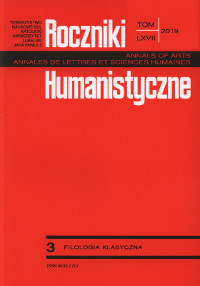Liczba podwójna w archaicznej poezji rzymskiej
Dual Number in the Archaic Latin Poetry
Author(s): Krzysztof Tomasz WitczakSubject(s): Language and Literature Studies, Philology
Published by: Towarzystwo Naukowe KUL & Katolicki Uniwersytet Lubelski Jana Pawła II
Keywords: archaic Roman poetry; dual number; elliptic dual; Latin morphology; Saturnian verse
Summary/Abstract: The archaic epitaph of Lucius Cornelius Scipio (son of Barbatus), consul of 259 BC, contains the Old Latin form Tempestātēbus (in the dative), referring probably to two goddesses of weather (CIL I2 9). This theonym proves the existence in the Old Latin language of the dual formation *Tempestātē ‘two deities of weather’. The word aide, attested in the epitaph of Scipio, son of Barbatus, can be easily interpreted as a possible form of the dual number, namely *aideē (nom.-acc. du. f.) ‘a bipartite (two-sided) temple; a sacral building with two sanctuaries’. Livius Andronicus used some forms of the dual number in his Latin translation of Homer’s Odyssey, among others genū (nom.-acc. du. n.) ‘two knees’ (fr. 14), inque manū (acc. du. f.) ‘and to both hands’ (fr. 5). It is not known, however, whether the use of the dual number in Andronicus’ Odussia was consistent or optional. Naevius introduced some dual forms into the epic work of Bellum Punicum, e.g. hōc Samnītē ‘these two Samnites’ (fr. 36). It seems, however, that the poet did not do it consistently. The metrical and linguistic analysis of the preserved fragments does not give a definite answer as to whether the use of forms of the dual number was obligatory in Naevius’ work, or was the result of the free choice of the Roman poet. In some passages passed down through indirect tradition, it was easy to arrive at the secondary plurality of the old dual forms.
Journal: Roczniki Humanistyczne
- Issue Year: 67/2019
- Issue No: 3
- Page Range: 107-123
- Page Count: 17
- Language: Polish

